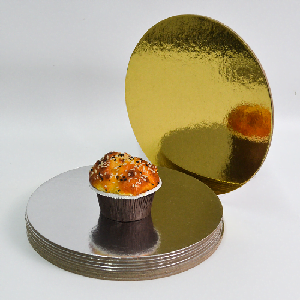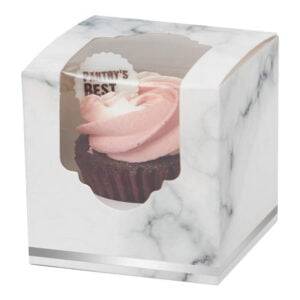Cake box packaging is more than just a vessel to transport delicate confections; it’s a statement of your bakery’s quality, a canvas for your branding, and a crucial factor in preserving the freshness of your baked goods. Choosing the right material for your cake boxes is a decision that can significantly impact your bakery’s environmental footprint, product presentation, and overall customer satisfaction. In this comprehensive guide, we will explore various materials ideal for cake box packaging, their pros and cons, and how to make an informed choice that aligns with your bakery’s values and goals.
Understanding the Role of Cake Box Packaging
 Before diving into the world of materials, it’s essential to grasp the multifaceted role that cake box packaging plays in the bakery industry.
Before diving into the world of materials, it’s essential to grasp the multifaceted role that cake box packaging plays in the bakery industry.
The Versatile Functions of Cake Box Packaging
- Protection: Cake boxes act as guardians, shielding your delicate creations from external elements such as humidity, dust, and physical damage during transportation.
- Presentation: A well-designed cake box isn’t just a container; it’s a stage that showcases your cake’s aesthetics. It adds to the anticipation and delight of the culinary experience.
- Branding: Cake box packaging is a canvas for your brand. It can feature your bakery’s logo, color scheme, and messaging, effectively reinforcing brand recognition and loyalty.
- Preservation: Beyond visual appeal, cake boxes are engineered to maintain the freshness and flavor of your cakes. They extend the shelf life of your products, guaranteeing that customers savor cakes that are as delightful as they are visually pleasing.
Now, let’s explore the various materials ideal for cake box packaging and their unique characteristics.
Common Materials for Cake Box Packaging
Cardboard
Pros:
- Sturdiness: Cardboard is known for its strength and durability, ensuring cakes remain intact during transport.
- Customizability: It’s highly customizable, allowing for various shapes, sizes, and designs.
- Eco-friendly: Many cardboard options are recyclable and made from renewable resources.
Cons:
- Not Waterproof: Cardboard is susceptible to moisture damage, so it may not be ideal for cakes with high moisture content.
- Bulkiness: It can be relatively bulky, adding to transportation costs.
Paperboard
Pros:
- Lightweight: Paperboard is lighter than cardboard, making it cost-effective for shipping.
- Customizable: It’s versatile and can be easily printed with vibrant graphics.
- Recyclable: Paperboard is often recyclable, contributing to eco-friendliness.
Cons:
- Less Sturdy: While suitable for many cakes, it may not provide the same level of protection as cardboard.
- Limited Water Resistance: Like cardboard, paperboard is susceptible to moisture.
Plastic
Pros:
- Waterproof: Plastic cake boxes offer excellent protection against moisture, making them suitable for cakes with fillings or high moisture content.
- Visibility: Clear plastic allows customers to see the cake without opening the box.
- Reusable: Some plastic cake boxes are designed for reuse, reducing waste.
Cons:
- Environmental Concerns: Traditional plastics can be non-biodegradable and contribute to plastic waste.
- Less Customizable: Plastic may have limited design and branding options compared to paper-based materials.
Eco-Friendly Options
Pros:
- Sustainability: Eco-friendly materials like biodegradable plastics, recycled cardboard, and compostable options reduce your bakery’s environmental impact.
- Consumer Appeal: Many consumers prefer businesses that use eco-friendly packaging, potentially attracting a more environmentally conscious customer base.
- Innovation: Advancements in sustainable materials offer both eco-friendliness and customizability.
Cons:
- Cost: Eco-friendly materials can be more expensive than traditional options.
- Availability: Depending on your location, it may be challenging to find a wide variety of eco-friendly packaging materials.
How to Choose the Right Material
 Considerations for Your Bakery
Considerations for Your Bakery
- Product Type: The nature of your cakes, whether they are moist, delicate, or intricate, will influence your material choice. Moist cakes may require moisture-resistant options, while delicate cakes might benefit from sturdier materials.
- Brand Image: Consider your bakery’s branding and image. Does your brand align with eco-friendliness, or do you aim for a more traditional aesthetic?
- Budget: Evaluate your budget constraints. While sustainable materials may cost more upfront, they can offer long-term benefits.
- Environmental Impact: Factor in your bakery’s commitment to sustainability. If environmental responsibility is a core value, opt for eco-friendly materials.
- Customer Preferences: Understand your target audience’s preferences. Are they eco-conscious consumers who prioritize sustainability?
Frequently Asked Questions (FAQs)
Q1: Are there biodegradable plastic options for cake box packaging?
A1: Yes, there are biodegradable plastics made from materials like cornstarch or potato starch. These options offer the durability of plastic with reduced environmental impact.
Q2: Can I find custom eco-friendly cake box packaging?
A2: Yes, many manufacturers offer custom eco-friendly packaging solutions. You can incorporate your branding while staying committed to sustainability.
Q3: What should I do if I need moisture-resistant packaging for my cakes?
A3: Consider using plastic or coated cardboard options for moisture resistance. However, be mindful of the environmental impact and disposal methods.
Q4: Are there recyclable plastic cake box options?
A4: Some recyclable plastic options are available, but the recyclability can vary depending on local recycling facilities. Check with your local recycling guidelines.
Q5: How can I communicate my bakery’s sustainability efforts to customers?
A5: Utilize your bakery’s website, social media, and in-store signage to inform customers about your sustainable packaging choices. Educate them on responsible disposal and recycling practices.
In conclusion, the choice of materials for cake box packaging is a multifaceted decision that involves considerations of functionality, branding, budget, and environmental impact. By carefully assessing your bakery’s specific needs and values, you can select the ideal material that enhances your brand, protects your cakes, and contributes to a more sustainable future. Remember, the material you choose is not just a box; it’s an integral part of the story you tell your customers.
 Considerations for Your Bakery
Considerations for Your Bakery